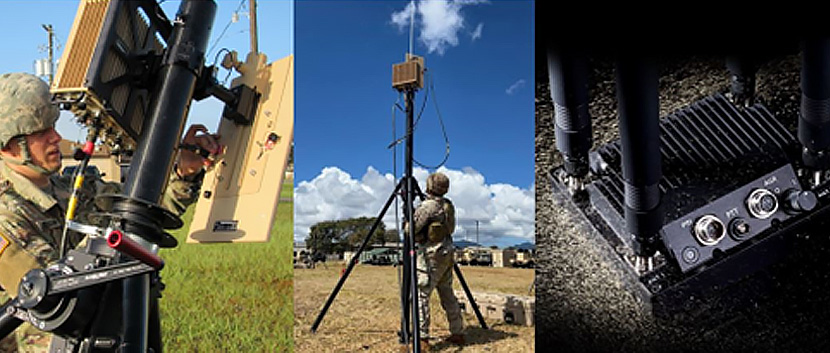
The high-capacity radio technologies in the Product Manager Network Modernization portfolio provide commanders with line-of-sight communication options – as well as beyond-line-of-sight via the current and next generation Tropospheric Scatter Transmission (Tropo) capabilities -- for a more resilient network in congested and contested environments. These high-capacity radio systems address the growing demand for distributing high-bandwidth data in harsh tactical environments, with lower latency than satellite communications (SATCOM). These solutions enable increased data flow between upper and lower echelons, and improved data fusion into the common operational picture at the brigade level and above. They are easy-to-deploy, set-up and tear-down to enable units to relocate rapidly, while delivering resilient network transport to ensure the exchange of critical real-time battlefield situational awareness to keep forces safe and ensure mission success. The high-capacity radio systems improve the expeditionary nature of U.S. Army units, while significantly increasing network throughput and range, operational flexibility and network resiliency through multipath diversity and enhanced primary, alternate, contingency and emergency (PACE) communications plans.
-
The Terrestrial Transmission Line-Of-Sight (TriLOS) Radio is deployed in a few transit cases, and its small form factor provides a significant reduction in size, weight and power (SWaP) compared to the High Capacity Line Of Sight (HCLOS) radio that it replaces. The system is much easier and faster to set up, operate, and maintain. The TriLOS radio increases the robustness of the Army’s tactical network by providing a significant increase in bandwidth and range, with lower latency than satellite communications. Increased bandwidth enables larger files to be sent over the network faster, such as imagery, maps, video and UAV feeds. It improves the speed of data and increases the flow of traffic on bandwidth hungry mission command systems. TriLOS enables commanders to push smaller units further out to the edge of the battle while keeping them connected to the network. It can also serve as relay capability and transfer signals to distant units.
TriLOS is a dual channel radio and can execute two responsibilities at the same time -- it provides point-to-point communications, but unlike the HCLOS, it will also provide point-to-multipoint communications, enabling Soldiers to shoot multiple shots with one antenna mast, versus needing extra antennas to shoot to multiple terminals. With TriLOS fewer radios, Soldiers and supporting resources are needed.
-
The Army’s next generation Tropospheric Scatter Transmission (Tropo) capability will provide expeditionary “beyond-line-of-sight” capability that will extend network range and significantly increase throughput, while greatly reduce size, weight and power (SWaP) requirements, compared to the current Tropo capability that it will replace. The system is easy to operate and deploy and requires only two Soldiers for rapid set-up/tear-down, enhancing command post mobility and survivability. This versatile commercial system can operate in satellite denied environments, and it will increase multipath diversity and enhance unit’s Primary, Alternate, Contingency, Emergency (PACE) communications plans in congested and contested environments. One of the biggest advantages of the next generation Tropo is its lower latency compared to satellite capability, improving the performance of the network, especially for real-time applications. When fielded, Tropo will be a key component of the Army’s Expeditionary Signal Battalion-Enhanced (ESB-Es) network tool suite.
The Army’s next generation Tropo system enables beyond-line-of-sight capability without satellites and can diffract signals over mountains. It uses tropospheric scattering capability, which bounces signals off of the Earth’s atmosphere to provide high-capacity beyond-line-of-sight capability without using expensive and limited satellite resources. It also uses particles in the atmosphere as reflectors for microwave radio signals. Tropo reduces the Army’s over-reliance on satellites, while saving significant costs by reducing expensive commercial satellite airtime leases. When fielded, the Army’s next generation Tropo will augment and expand the transport capacity of the Army’s tactical network.
-
The Mid-Tier Backhaul Radios are similar to TriLOS but with less range and bandwidth. However, unlike TriLOS, this resilient mesh radio does not use directional antennas; it provides point-to-point, multi-point to point and multi-point to multi-point connectivity. It is portable, rapidly deployable, and units are able to operate on the move.
This brigade and battalion-level mesh radio is an extension of the line-of-sight radio network provided by TriLOS, and it is self-forming/self-healing without need for human intervention. Mesh radio nodes are provided for command post use, integrated onto vehicles (such as Strykers and Joint Light Tactical Vehicles) and can even be used from Unmanned Aircraft like Gray Eagle and variable height antennas.
-
The Tactical Radio Integration Kit (TRIK) provides radio-bridging capability at the battalion and company level. TRIK integrates multiple varieties of tactical radios to enable different user groups, such as U.S. and coalition forces, to seamlessly communicate with different radios. All of the radio technologies are key components of the Army’s Capability Set modernization efforts, including the Expeditionary Signal Battalion-Enhanced and the Integrated Tactical Network (ITN) equipment sets, providing high-capacity terrestrial data transport.
Capabilities
- Adds multipath diversity, enhanced PACE communications, and operational flexibility to the tactical network
- Operates in satellite denied environments
- Significant SWaP reduction over previous capability for improved unit agility
- Significant increase in bandwidth and range versus previous capability
- Easy to operate and deploy; requires only two Soldiers for rapid set-up/tear-down, enhances command post mobility and survivability
- Fully interoperable with the Army’s tactical network and architecture
- Reduces the Army’s reliance on satellites; saves significant costs by reducing the use of expensive commercial satellite airtime leases